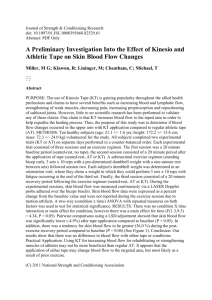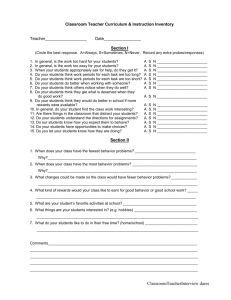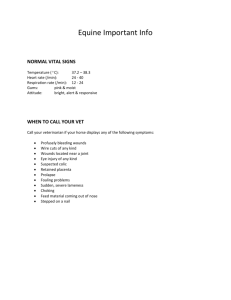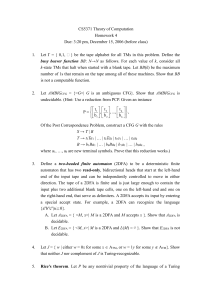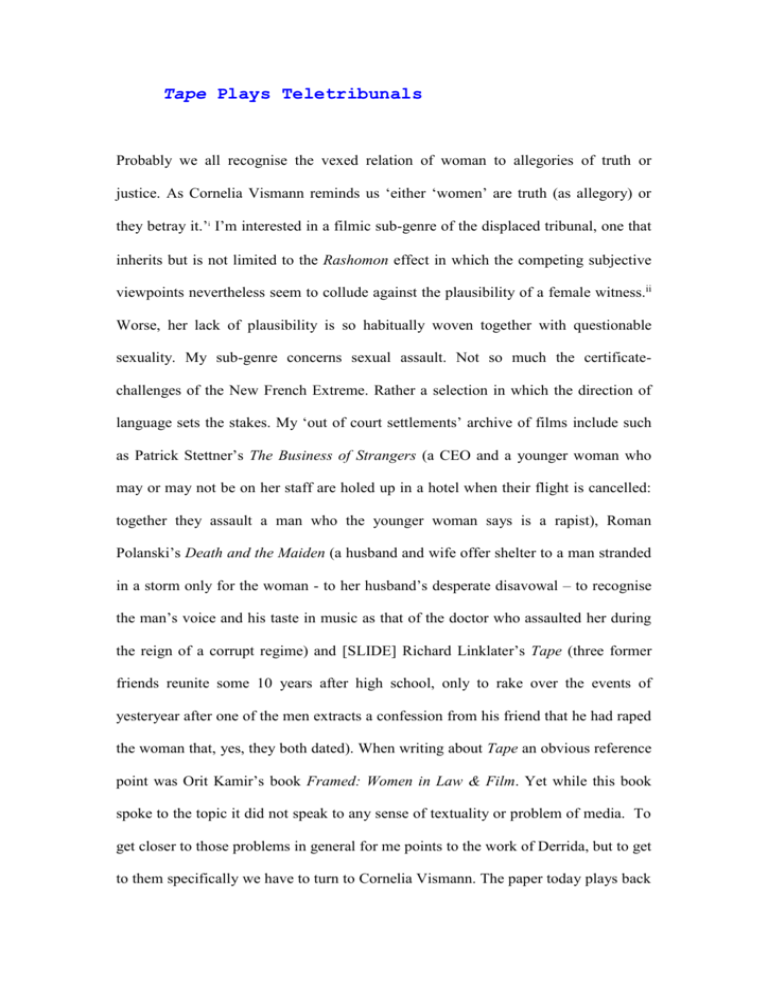
Tape Plays Teletribunals
Probably we all recognise the vexed relation of woman to allegories of truth or
justice. As Cornelia Vismann reminds us ‘either ‘women’ are truth (as allegory) or
they betray it.’i I’m interested in a filmic sub-genre of the displaced tribunal, one that
inherits but is not limited to the Rashomon effect in which the competing subjective
viewpoints nevertheless seem to collude against the plausibility of a female witness.ii
Worse, her lack of plausibility is so habitually woven together with questionable
sexuality. My sub-genre concerns sexual assault. Not so much the certificatechallenges of the New French Extreme. Rather a selection in which the direction of
language sets the stakes. My ‘out of court settlements’ archive of films include such
as Patrick Stettner’s The Business of Strangers (a CEO and a younger woman who
may or may not be on her staff are holed up in a hotel when their flight is cancelled:
together they assault a man who the younger woman says is a rapist), Roman
Polanski’s Death and the Maiden (a husband and wife offer shelter to a man stranded
in a storm only for the woman - to her husband’s desperate disavowal – to recognise
the man’s voice and his taste in music as that of the doctor who assaulted her during
the reign of a corrupt regime) and [SLIDE] Richard Linklater’s Tape (three former
friends reunite some 10 years after high school, only to rake over the events of
yesteryear after one of the men extracts a confession from his friend that he had raped
the woman that, yes, they both dated). When writing about Tape an obvious reference
point was Orit Kamir’s book Framed: Women in Law & Film. Yet while this book
spoke to the topic it did not speak to any sense of textuality or problem of media. To
get closer to those problems in general for me points to the work of Derrida, but to get
to them specifically we have to turn to Cornelia Vismann. The paper today plays back
some reflections on Tape in light of Vismann’s work on the competing interplay of
media in the trial and the tribunal.
‘If television cameras are present in court proceedings, elements that have
their origins in the disorder of the tribunal will of necessity seep into the court
trial. The ritual of the legal search for justice will give way to the logic of the
duel.’iii
Vismann is writing of the emergence of the televised trial, of the imposition of the
order of televisuality and its requisite technologies upon the inherited order of the trial
proper. The conceits of the camera take up both space and authority as point-of-view
that they were not allotted.
In the case of Tape, we do not have a televised trial. Rather we have a film, adapted
from Stephen Belber’s play of the same name, shot by Richard Linklater over the
course of 6 days with then novel digital video (no tape as such). The apparent use of
real time – 86 minutes restricted to the rudimentary room 29 of the Motor Palace
motel – is fictitious not only in the sense that the film does not labour to conceal its
cuts or its handheld camerawork but also in the sense that the speech-intensive
‘action’ of this film so rewrites the events of 10 years previously that temporal
questions like ‘what happened?’ and ‘when?’ become difficult. Often matching the
rapid and heated verbal exchanges with its own whip-pan volleys, the camera does
not act as dispassionate judge but is involved. By extension, as Vismann notes, the
camera teleports a whole other juridical audience into the scene, aligning and
realigning identifications.
Given Vismann’s combined investigation of law and visual culture, she also remarked
on the insertion of cameras into the courtroom in cinema. A crisis is wrought or
averted with the aid of the visual evidence supplied by the camera that, with a
performative force par excellence, never lies. The diegetic insertion of technology as
evidence, index, analogy is absent and present in Tape in several ways. This is a film
in which a man is coerced into confessing a sexual assault that is surreptitiously
recorded on tape, and the victim is summoned to receive the gift of apology, which
she refuses. More literally legalistic films would not be able to refuse a flashback,
would not be able to resist supplying the visual evidence signifying memory. They
would restore the missing images, relieve us from the adult anxiety of room 29 and
dally in the teenage tensions of a high school graduation party. Is it mere mediumistic
inheritance that leads tape to refuse the expectation of flashback? No, since Tape also
sensibly dispenses with the optional prologue and epilogue from Belber’s original
play. Tape refuses to play this game. The task of Tape is not to seek out the truth.
Rather Tape stakes out the only too familiar trope of the exchange of women between
men and were Amy to show and tell (executed cinematically as flashback) this would
only pander to her place in their story. Whether victim or not, the one thing she is, is
‘hot.’ While some online reviews persist in misreading the narrative of Tape as one
about two friends, with the woman already sequestered within their script, it is one of
the strengths of the film that, through the making of a tape-recording, the trope of
gender is exposed and not consolidated. It is not only that the displaced tribunal of
Tape ironizes the trial and delivers a witty reversal of a ‘dumb guy and smart guy’
routine in so doing. Rather, it is the unexpected participation of the woman who
blanks the script written for her as evidence or trophy or other object (a cassette tape
even), and rather sends the legalistic performatives of the film into overdrive. Jon’s
technical mediation in Tape is also at stake, not through visual flashback but through
audio playback.
For it is a cassette tape, rather than a camera, that is embedded within this film as the
index of its archive fever. Upfront, the film’s title Tape takes an aspirational centre
stage; [SLIDE] unravelling magnetic tape is suggested as the titles snake across the
screen bracketing the film; [SLIDE] a cheap cassette circulates from hand to hand
within the narrative. This cassette might be a legal object - it does contain what
appears to be the confession of a sexual assault never previously brought to justice.
Yet Vince, who engineers the production of this tape, barely refers to it as something
that might enter a legal environment other than the effective tribunal of room 29 of
the Motor Palace. The tape, it seems, is not for the record. The two named trajectories
for the tape are, firstly, that it could be given to Amy who might be ‘interested’ to
hear its contents – this before the pair realise that Amy is now an Assistant District
Attorney, and secondly that this might spark the beginning of Vince’s own movie
career. Like the more socially-mobile Jon, who is screening his first film at the
Lansing Film Festival – the ostensible occasion for this school reunion – Vince too
might use art to transcend his life, to learn from his mistakes, and make something
meaningful.
Unlike a flashback that is used to convey memory, that is memory as cinematically
configured according to a very narrow prescription of a reel that can more or less
simply be rewound and replayed, in this temporally concentrated motel room, we see
Vince manufacture the tape. [SLIDE] It is quite the production. Though we learn that
the subject of Amy always comes up whenever these two guys get together, this time,
under the makeshift interrogation lights of Room 29, Vince wont let Jon off the hook
and, in the manner of a belligerent prosecution, needles Jon into revealing ‘what
happened’ that night at the party after graduation. We should note that the
conversation between the two of them has already set up the question of violence; of
what merely amounts to a ‘threatening appearance’ and of what might constitute
violence as such, and articulated in similar terms, whether one of them merely ‘acts in
a phallic fashion’ or actually is ‘a dick’. Jon’s subsequent contorted concession that
he applied ‘excessive linguistic pressure’ as the means with which to coerce Amy into
having sex with him might be easily caricatured by Vince as ‘bullshit,’ but it is not the
suggestion that the language of force is either the prequel to or the mask of violence
in the world that is most interesting, rather it is that language is not signification alone
but also force.
Writing of the discrepant methods used by Michel Foucault and Pierre Legendre in
their treatment of the trials of Pierre Rivière and Corporal Lortie respectively,
Vismann pays attention to their understanding of the relation between writing,
especially written confession and the deed of murder. In the case of Foucault,
Rivière’s belated statement is yet understood by Foucault as predictive of his crime.
Vismann writes that ‘Speech acts reveal their tragic dimension […]. Once let loose,
they cannot be stopped in their tracks.’iv What is compelling about Tape is that while
speech acts are indeed let loose and cannot in a sense be stopped, their tracks are not
analogue, reference to ‘tape’ notwithstanding. They do not simply or irrefutably
betray the one who made them, pointing them out. In spite of technology’s promise to
capture that which it records – and the perfect copy made by the low-end Walmart
tape recorder hidden in a bag under a table on the other side of the room gives the lie
to this fantasy – every track remains beholden to the countersignature of the other. I’ll
come to Amy’s devastating response to the trap in which she manages not to be set
soon. First I will address the complex character of Jon’s confession and the
concomitant stream of apologies by way of Vismann’s critical presentation of
Legendre as well as Derrida’s attention to the performative genre of Confessions.
For Foucault as there would be for Derrida, there are multiple procedures of
truthfinding at stake in a trial, which may ‘found’ rather than simply ‘find’ that which
they seek. For Legendre attention is more narrowly focused upon the field of
language, a field construed as having been wounded by a deed without a word, a
crime without an accompanying sentence: this wound must be redressed by the court
proceedings; the court must enjoin the accused to refer to the crime in the first person
(‘I killed X…’). The restitution effected by the use of the first person is towards that
of the institution of language. Every trial addresses itself to this larger criteria through
the sentence that the defendant must utter in the first person, thus the stakes always
point beyond the individual crime. They point towards a ‘cure for the office of the
father’ as Vismann says, suggesting that a paternal metaphor of language is at stake.v
If we do not have ‘missing images’ supplied by Tape, if we cannot see ‘then,’ we
have instead yet more words (Tape is already verbose). The forging of the tape
produces an aural slippage in the otherwise visually consistent room: it is only played
back once for verification, immediately after Jon eventually and crudely shouts, in the
first person, that he ‘pinned her arms back and stuck [his] dick in.’ In Legendre’s
terms, as presented by Vismann, we have a result. The tape repeats the most
incriminating sentence; Jon is later to say, under pressure from Amy as to why he
suddenly 10 years later wants to apologise, that after hearing what he said on the tape,
what he did ‘hit him’ and he wanted to say that he was sorry. Not during the event,
not during the confession, but on hearing himself speak on tape, Jon is struck by his
own deed.
Jon is also wounded in the heat of the exchange with Vince, not so much because he
has now spoken about that night at the party, but because Vince so wound him up as
to make him talk of it, and on tape too. His authority is in question, and Jon is the
film-maker here. While Tape resists the temptation to have the outraged Jon literally
complain of Vince taping him without consent, the association is in the air, and this
between two men, one or more of who may be a dick.vi I say this not just to be
contentious or flippant, but because I think the film is highly conscious of the
phonetic and typographic similarity between the two words, tape and rape. [SLIDE]
Tape: an archival medium that should faithfully store the contents it captures. I’ve
suggested already that the cheapness of Vince’s tape, not to mention its now antique
status in the history of technology, and our generation’s memory of the ready
fallibility of such media, suggest the reverse. But the problem is not simply that
storage media might fall apart, be literally divisible, although it might. Rather the
supplement that the recording donates to that which is recorded always reinscribes the
event and does not simply re-present it. As Derrida writes, ‘the archive produces the
event no less than it records or consigns it.’vii Likewise, rape as a meaningful
inscription loses ground. In the singular case of this film, Jon’s actions, as well as his
speech, are vulnerable to the countersignature of the other. Thus, in the face of Jon’s
effusive, near endless, apologies, Amy says she was not raped. Again, while nervous
laughter is prompted on numerous occasions, the film is not at all facetious about this
subject matter, neither does it remove or belittle the criminality of sexual assault.
Rather than introduce Amy – the last one of the three to arrive at the Motor Palace –
as the final witness to and guarantee of this rape narrative, Tape changes tack. Tape
the film and the Walmart cassette part company. Rather than remain the ruse through
which the relation between Jon and Vince is held in place, Amy undoes their
authority. Rather than simply refuse the apology because she says she was not raped,
Amy structurally recodes it as a speech act that does not have her as its object or the
intention to apologise as its aim.
Putting pressure on what is called apology, Amy’s effective re-write brings out Jon’s
uncanny repetition of the genre of Confessions as diagnosed by Paul de Man and by
Derrida.viii There should be no trace of repetition in such a thing as confession. De
Man elaborates problems with the performative capacity of confession through
Rousseau who, in writings 10 years apart, confesses to the same event twice (that
event, famously, being putting the blame for the theft of a ribbon that Rousseau
himself had stolen onto a convenient servant girl, Marion). De Man plots out these
two instances, from Rousseau’s Reveries as well as the eponymous Confessions, such
that the first registers as the confession of an event and the second as the machinic
making of an excuse. The sinister insinuation of the latter manifests in the
transference of the guilt from committing an offence, to the guilty pleasure in writing
about it.
Throwing out of court Jon’s professed sincerity of apology, Amy counters: ‘You
didn’t like what you said on the tape Jon, so you came back to say it little more
eloquently.’ As with Rousseau, the apology serves only to prolong Jon’s airtime and
to broadcast his guilt. For while it required substantial goading for Vince to
sufficiently wind Jon up until his confession bursts out, once started, he can barely
stop. [SLIDE] He really is sorry! Truly. Genuinely. Sincerely. This windbag
apologises something like 9 times, not to mention those uttered ‘in general’ before
Amy arrives.
Without detailing the breadth of Derrida’s intervention here, suffice to say he pulls De
Man up for apparently forgetting that Rousseau is already in a state of repetition in his
curious structural duplication of the confession of a minor crime as pivotal moment in
that other inaugural work, Augustine’s Confessions. Moreover, Derrida finds De Man
overly close to a duplication of the separation of constative from performative when
he separates event of confession (in the first instance) to the machine of excuse or
apology (in the second or any other instance). While event is traditionally conceived
as spontaneous, affective and organic and while the mechanical is thought of as
repetitious, unfeeling, automata, Derrida comes to hyphenate the two. He recasts the
performative that holds out so much temptation for the spontaneous, as machineevent. The perversion that is pleasure in writing is there from the ‘first’. ‘First’ like
‘when’ in the belated relays of Tape, is difficult to determine, and the archives of the
confession are, as Derrida remarks, ‘interminable’.ix Thus speech acts cannot be
stopped, not because they command unerring precision, but because their course can
always be redirected…
These remarks echo those of Vismann in her conclusion to the essay on the question
of ‘replaying the crime’ (‘Rejouer les Crimes’). There, instead of magnifying a fear of
media and calling a halt to the intercession of images in the name of the judge,
Vismann points to the ‘play of gazes’ in the theatre of justice as already themselves
citational – the machinic quality to which reprographic media draw attention and
which De Man framed as secondary.x Citationality, in all senses, is exploited by Amy.
It is not that only Amy constitutively can have the last word – and a last word that she
explicitly denies to Jon – but rather that the force of surprise is so much on her side
that neither man knows how to continue.
Amy derails the authority of Jon’s actions as his apology retroactively positions them
by saying that she was not raped, ruining the first person affirmation of his linguistic
reparation. Jon may well have been ‘reckless’ as to Amy’s consent that night – and it
comes as another shock for him to learn that she was then in love with him.xi Putting
his hand over her mouth certainly contributed to the lack of any accompanying speech
on her part that night. But speaking now in room 29, Amy rewrites the place where
she is expected to be as the passively functioning tape recording the inscriptions of
the men. Tape decks the twin clichés of gender and technology – of inscription as
phallic mark on virgin ground, and of passive feminine sexuality as inaugurated in
reaction to the active ‘writing’ of masculine sexuality. In this light, Jon’s insistence
that he really means what he says and his pleas for Amy to accept his apologies
function as another attempted insemination.
Now Amy’s rewrite is not easy. Twice more she demonstrates her distance from their
plot. Firstly, she lets rip a stream of lurid invective at Jon wishing a brutal assault
upon his person, only to abruptly shift with disarming irony into a smile, charging the
men with having prescribed just such a performance. As they reel she delivers another
blow. Mobilising the language of the law, she fakes a phone call to the police and
appears to shop both Jon and Vince, the first for a ‘verified’ Criminal Sexual Conduct
felony and the second for possession of illegal substances. [SLIDE] Unable to
marshall further apologies to a body for whom they cut no ice, Jon hands himself over
to the judgement of the other. Meanwhile, Vince in panic flushes his drugs and
destroys the tape he had so laboured to make. Revealing the hoax, Amy leaves the
room, leaves Tape, and leaves the men without their alibi, both in the end the ‘dumb
guy’.
Remarkable extradiegetically as it is that Robert Sean Leonard [Jon] in a cast
interview still refers to Tape in comparison to Rashomon as if we end this film unable
to decide between the testimonies of the two witnesses, and, that several years after
the release of Tape, Uma Thurman was to front a number of execrable Virgin Media
advertisements in which she personified exactly the kind of domesticated media that
is deconstructed in Tape, Tape nevertheless displays the ‘ordeal’ of the decision, on
which Vismann was to insist in her seminars on Derrida’s ‘Force of Law’ at
Goldsmiths.xii It is not that Amy becomes identical with justice, fully present at such.
The calls she makes, as I’ve suggested are shot through with citational precedent, yet
her audience do not see this machine-event coming.
i
Vismann, ‘Beyond Image’ 43.
Kamir discusses Rashomon at length.
iii
Vismann, ‘Teletribunals’ 18
iv
Vismann, ‘Rejouer’ 165
v
Vismann, ‘Rejouer’ 167
vi
NB. ‘dick’ as colloquial for detective.
ii
vii
Derrida, ‘Typewriter Ribbon: Limited Ink II’ 101
Derrida, ‘Typewriter Ribbon: Limited Ink II’, Paul de Man ‘Excuses
(Confessions)’
ix
Derrida, ‘Typewriter Ribbon: Limited Ink II’ 71
x
Vismann, ‘Rejouer’ 174
xi
Legal scholar Ngaire Naffine notes both that the UK Sexual Offences Act includes
the codicil that a man may be judged guilty of rape if he is ‘reckless’ as to whether the
woman consents (21, n.67) and that in Australian legislation the Victorian Parliament
includes silence on the part of the woman as ‘enough to show that the act took place
without that person’s free agreement’ (37). See her ‘Possession: Erotic Love in the
Law of Rape’ in The Modern Law Review, 57:1, 1994, 10-37.
xii
Derrida, ‘Force of Law’ 24.
viii







